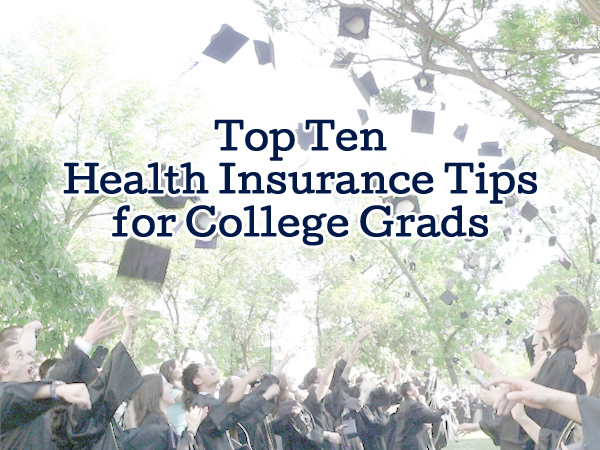It’s the time of year again – graduation season! With graduation comes a lot of changes for recent grads. Could your health insurance coverage be one of them? If your plan is ending or you’re moving away from school, it may be time to check on your coverage and make sure it’s still the best fit for your needs. Luckily, eHealth has published tips to help grads know what to look for when assessing their current coverage.
Many recent grads may have coverage under their parent’s plans. That’s great, since this coverage will not go away after a student graduates, unless the student turns 26. As for the many students on student health plans through their colleges, they may lose coverage once classes end. Though open enrollment is no longer open, if a graduate experiences a qualifying life event, like marriage, moving to a new area, or the loss of qualifying health insurance coverage, they can purchase coverage on their own.
eHealth has developed a helpful list for recent grads and their families to help you figure out what kind of health plan you need. Here are their Top Ten Health Insurance Tips College Grads:
-
Know a qualifying life event when you experience one. A qualifying life event allows you to purchase an Obamacare-compliant health insurance plan outside of open enrollment and apply for subsidies to help you pay your monthly premiums… College graduation is not a qualifying event. However, losing Obamacare-compliant coverage that you received through school, a job, or your parents may be a qualifying life event. Moving to a new city or state may also be a qualifying life event. Work with a licensed agent like those at eHealth to learn if you’re eligible to enroll in an Obamacare-compliant plan when you graduate.
The skinny: Figure out your next step after school, and figure out if you qualify for coverage. A licensed insurance agent can help you figure this out and help advise on what plans make sense for you.
-
Review ALL your coverage options.…Is your current health insurance plan really the best choice for you? It’s time to re-examine your options, all of them. When it comes to health insurance, these may include purchasing coverage on your own, sticking with Mom and Dad’s plan, or enrolling in coverage through an employer, among others. If you don’t have coverage from a parent, employer, school, or other source, you should consider buying coverage on your own. Keep an open mind and review the coverage options available to you through a variety of sources.
The skinny: Review all of your options to see what makes the most sense for your situation. There may be several avenues where you can get coverage and it may be well worth your time to compare how they stack up against one another.
- Buying coverage on the cheap may cost more than you think — or can afford. Don’t pick your next health insurance plan based only on which one has the lowest monthly premium. Instead, look at the “maximum out-of-pocket” amount for any plan you’re considering. This is what you could potentially need to pay, in addition to your premiums, for covered medical care in a worst-case scenario (like a serious illness or an injury requiring hospitalization). A monthly premium of $150 (for example) might sound great until you realize that your maximum out-of-pocket cost would be $6,000! If the lowest-premium plan is all you can afford, consider buying an accident or critical illness plan on the side to help cover your out-of-pocket costs in a worst-case scenario.
The skinny: This is great advice from eHealth. Make sure you consider your out-of-pocket exposure and whether that is something you can truly afford.
- Think twice before sticking with Mom and Dad’s health plan. The Affordable Care Act allows your parents to keep you on the family health insurance plan until you turn 26. That’s a pretty good deal. However, Mom and Dad aren’t required to keep you on their plan and it may cost them to do so. What’s more, if you live away from home, in another city or state, your access to network doctors and hospitals through your parents’ plan may be limited or non-existent…
The skinny: Staying on your parent’s plan may seem like an obvious and best choice, but make sure to consider the costs and access you’ll have to the network.
- Look beyond government exchanges. If you experience a qualifying life event and find yourself shopping for health insurance, don’t limit yourself to government-run health insurance exchanges. There are other plans available outside of government exchanges that can also meet your coverage requirements under the Affordable Care Act. To find the plan that best meets your needs and budget, compare the options available through your government exchange with other options available through private online marketplaces like eHealth…
The skinny: You have several options available to you for searching for a plan. Make sure to look at both government-run and private marketplaces to see all of your options, or a marketplace that pulls plans from both like HealthPocket.
- Consider short-term coverage for the in-between times. If you don’t expect employer-based health insurance to kick in for a while and you’re not eligible for (or can’t afford) coverage through another source, consider a short-term health insurance plan. Just make sure you understand what you’re buying. A short-term plan is a form of temporary coverage (from 30 days up to 12 months). It will not meet your coverage requirements under the Affordable Care Act, meaning that you may still be subject to a tax penalty. Short-term plans also may not provide coverage for preventive care, pre-existing medical conditions, or prescription drugs. However, short-term plans are relatively inexpensive and may limit your financial risk for medical care received for unexpected illnesses or injuries that are covered.
The skinny: Short-Term coverage is meant to be used temporarily, so if you are in a situation where you’ll be without permanent coverage for a short amount of time this coverage may make sense. Be careful, you may face tax penalties and won’t get nearly as much coverage as a traditional plan.
- Keep an eye open for the next open enrollment period. The next nationwide open enrollment period for self-purchased health insurance is coming up on November 1, 2015. If you’re not eligible to sign up for traditional major medical health insurance after graduation, this will be your chance to do so. Don’t let it pass you by. Even if you find major medical coverage after graduation, you should use the upcoming nationwide open enrollment period to make sure you’ll have the best plan for your needs into 2016.
The skinny: The next open enrollment period begins November 1, 2015. Be sure to check it out – you may find a better plan in the marketplace then.
- Check your subsidy eligibility. If you experience a qualifying life event allowing you to enroll in coverage outside of open enrollment, find out if you qualify for a government subsidy to help you afford health insurance. In order to qualify, your projected income for 2015 can be no more than 400% of the federal poverty level, which is about $47,000 for a single person. Be aware, however, that unexpectedly earning more this year could mean that you end up having to pay back some or all of your subsidy dollars. To learn about your eligibility for a health insurance subsidy, work with a licensed agent or your state’s government exchange.
The skinny: You may qualify for a subsidy to help you pay for your insurance. Check with an agent or your state’s government exchange to figure out if you qualify.
- Consider a “catastrophic” health insurance plan. These are major medical plans intended primarily for people under age 30. They provide less coverage overall than typical health insurance plans but may be more affordable on a month-to-month basis. They’ll meet your coverage requirements under the health care reform law, but you can’t use government subsidies to help pay for them. Catastrophic plans might be a good choice if you can’t afford more robust coverage but want something to back you up in case of an emergency. Just be sure that you could pay your deductible if you had to.
The skinny: Can’t afford a regular plan? Consider a “catastrophic” health plan. You’ll get less coverage overall, but it will meet coverage requirements.
- Understand your tax obligations if you go uninsured for 2015.Being uninsured the day after graduation doesn’t mean that you’ll automatically have to pay a tax penalty. Under the Affordable Care Act, tax penalties are typically triggered when you go uninsured for three consecutive months or more than once in the same calendar year. There are also exemptions for people with very low incomes or certain other circumstances. If you’re tempted to go uninsured after graduation, make sure you understand what your tax penalty may look like. For 2015, the tax penalty for going uninsured is the greater of $325 or 2% of your taxable income. Depending on how much you earn in 2015, your tax penalty for going uninsured could be hundreds of dollars or more.
The skinny: If you go uninsured, you’re not only opening yourself up to the financial risks of an unexpected medical issue, but also the tax penalties that go along with being uninsured for three consecutive months. Make sure you understand this penalty.
With so many changes happening as you graduate, these great tips from eHealth can help you ensure that you’ll have the right health insurance coverage once you graduate school.




